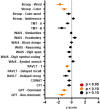Neuropsychiatric outcomes following strokes involving the cerebellum: a retrospective cohort study
- PMID: 37469842
- PMCID: PMC10352988
- DOI: 10.3389/fnins.2023.1203488
Neuropsychiatric outcomes following strokes involving the cerebellum: a retrospective cohort study
Abstract
Introduction: Given the wide-ranging involvement of cerebellar activity in motor, cognitive, and affective functions, clinical outcomes resulting from cerebellar damage can be hard to predict. Cerebellar vascular accidents are rare, comprising less than 5% of strokes, yet this rare patient population could provide essential information to guide our understanding of cerebellar function.
Methods: To gain insight into which domains are affected following cerebellar damage, we retrospectively examined neuropsychiatric performance following cerebellar vascular accidents in cases registered on a database of patients with focal brain injuries. Neuropsychiatric testing included assessment of cognitive (working memory, language processing, and perceptual reasoning), motor (eye movements and fine motor control), and affective (depression and anxiety) domains.
Results: Results indicate that cerebellar vascular accidents are more common in men and starting in the 5th decade of life, in agreement with previous reports. Additionally, in our group of twenty-six patients, statistically significant performance alterations were not detected at the group level an average of 1.3 years following the vascular accident. Marginal decreases in performance were detected in the word and color sub-scales of the Stroop task, the Rey Auditory Verbal Learning Test, and the Lafayette Grooved Pegboard Test.
Discussion: It is well established that the acute phase of cerebellar vascular accidents can be life-threatening, largely due to brainstem compression. In the chronic phase, our findings indicate that recovery of cognitive, emotional, and affective function is likely. However, a minority of individuals may suffer significant long-term performance impairments in motor coordination, verbal working memory, and/or linguistic processing.
Keywords: Rey auditory verbal learning test (RAVLT); basilar artery; grooved pegboard test; posterior cerebellar artery; stroke; stroop test.
Copyright © 2023 Muller Ewald, Deifelt Streese, Bruss, Manzel, Montilla, Gala, Tranel and Parker.
Conflict of interest statement
The authors declare that the research was conducted in the absence of any commercial or financial relationships that could be construed as a potential conflict of interest.
Figures




References
-
- Al B., Des K., and Sivan A.B., Multilingual aphasia examination. AJA associates (1997).
-
- Beck A.T., Steer R.A., Brown G., Beck Depression Inventory–II (1996).
Grants and funding
LinkOut - more resources
Full Text Sources

